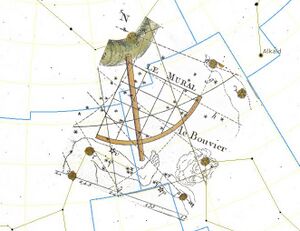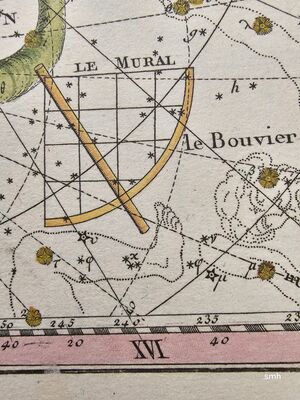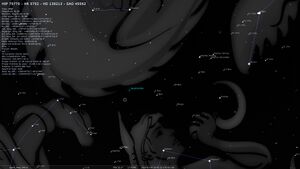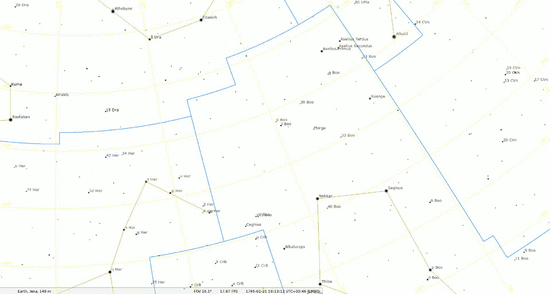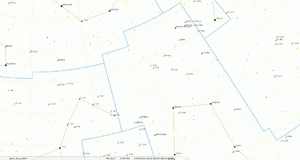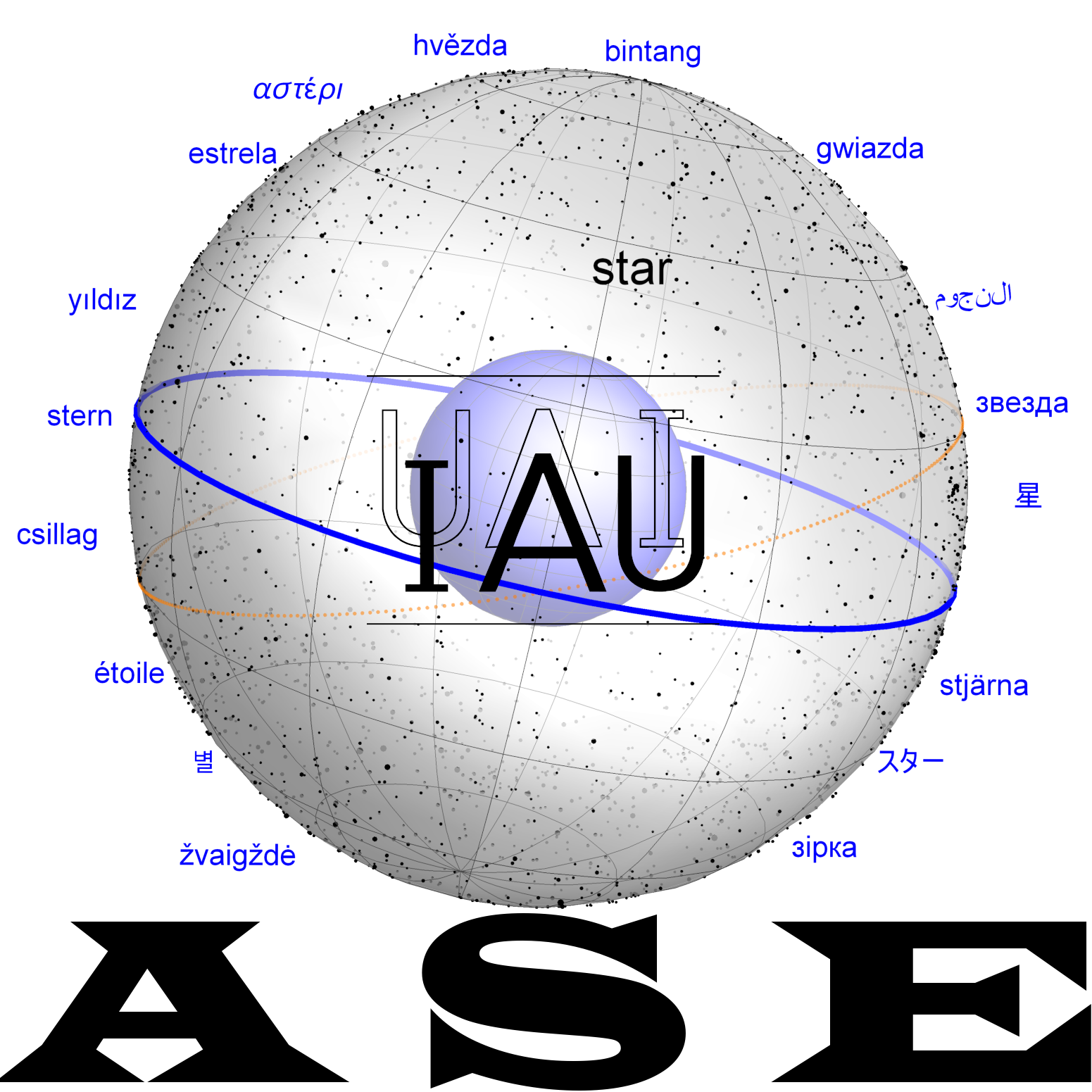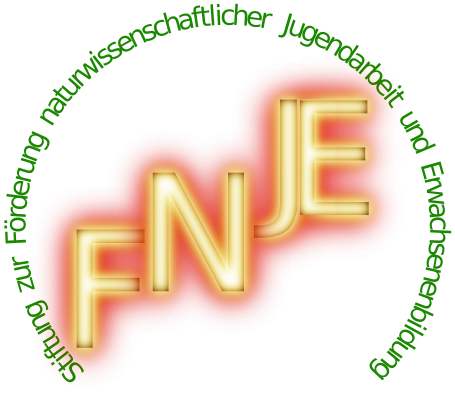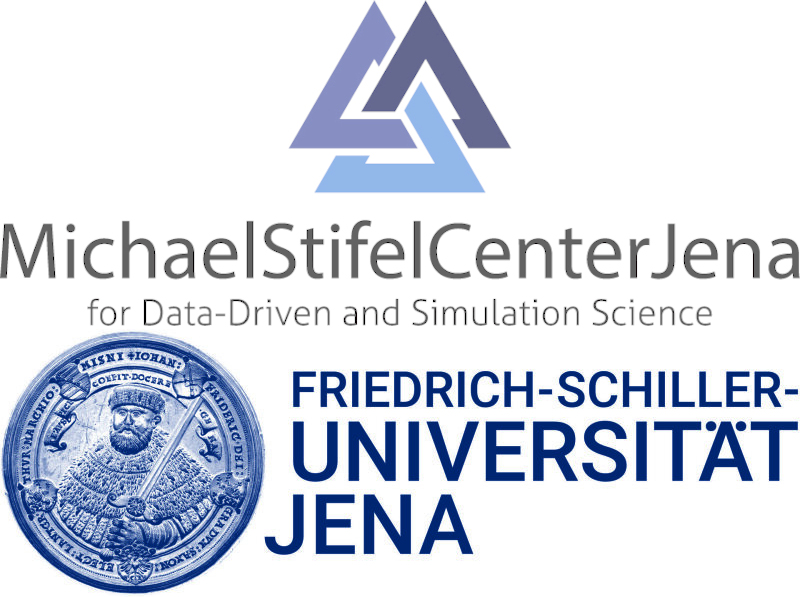Quadrans: Difference between revisions
No edit summary |
|||
| Line 41: | Line 41: | ||
For A, it displays the "note": "Not recovered in Gaia DR3 (see [https://vizier.cds.unistra.fr/viz-bin/VizieR?-source=I/350/gaiaedr3 I/350/gaiaedr3])". Some of the very brightest stars do not appear in Gaia DR3 (alpha Cen A and B are great examples). 44 Boo is a bit of an unusual triple system (at least)<ref>WDS Notes https://vizier.cds.unistra.fr/viz-bin/VizieR?-6N&-out.form=H0&//*&-source%3DB/wds/notes&WDS%3D%3D%3D15038%2b4739</ref> as both components seem to be binaries: A seems to be a spectroscopic binary, the B component is a W UMa system<ref>Hill, G., Fisher, W. A. and Holmgren, D. (1989). Studies of Late Type binaries I. The physical parameters of 44i Bootis ABC, Astronomy and Astrophysics, 221, 81-98. [https://ui.adsabs.harvard.edu/abs/1989A%26A...211...81H/abstract ADS ABS]</ref> (perhaps the nearest contact binary to the Sun) with known RV orbit<ref>Lu, Wenxian ; Rucinski, Slavek M. ; Ogłoza, Waldemar (2001). Radial Velocity Studies of Close Binary Stars. IV. The Astronomical Journal, 122, 1, 402-412. [https://ui.adsabs.harvard.edu/abs/2001AJ....122..402L/abstract ADS ABS]</ref> and more recent analysis including TESS data<ref>R.H. Nelson (2023), 44 Boo – A unified integrated light curve analysis, New Astronomy, 98, <nowiki>https://doi.org/10.1016/j.newast.2022.101901</nowiki> [https://www.sciencedirect.com/science/article/pii/S1384107622000926 SCIENCE-DIRECT]</ref>. 0It appears that Gaia DR2 successfully split the bright pair A and B and provided two entries, but Gaia DR3 barfed on A (no entry) and only provided information on the B. |
For A, it displays the "note": "Not recovered in Gaia DR3 (see [https://vizier.cds.unistra.fr/viz-bin/VizieR?-source=I/350/gaiaedr3 I/350/gaiaedr3])". Some of the very brightest stars do not appear in Gaia DR3 (alpha Cen A and B are great examples). 44 Boo is a bit of an unusual triple system (at least)<ref>WDS Notes https://vizier.cds.unistra.fr/viz-bin/VizieR?-6N&-out.form=H0&//*&-source%3DB/wds/notes&WDS%3D%3D%3D15038%2b4739</ref> as both components seem to be binaries: A seems to be a spectroscopic binary, the B component is a W UMa system<ref>Hill, G., Fisher, W. A. and Holmgren, D. (1989). Studies of Late Type binaries I. The physical parameters of 44i Bootis ABC, Astronomy and Astrophysics, 221, 81-98. [https://ui.adsabs.harvard.edu/abs/1989A%26A...211...81H/abstract ADS ABS]</ref> (perhaps the nearest contact binary to the Sun) with known RV orbit<ref>Lu, Wenxian ; Rucinski, Slavek M. ; Ogłoza, Waldemar (2001). Radial Velocity Studies of Close Binary Stars. IV. The Astronomical Journal, 122, 1, 402-412. [https://ui.adsabs.harvard.edu/abs/2001AJ....122..402L/abstract ADS ABS]</ref> and more recent analysis including TESS data<ref>R.H. Nelson (2023), 44 Boo – A unified integrated light curve analysis, New Astronomy, 98, <nowiki>https://doi.org/10.1016/j.newast.2022.101901</nowiki> [https://www.sciencedirect.com/science/article/pii/S1384107622000926 SCIENCE-DIRECT]</ref>. 0It appears that Gaia DR2 successfully split the bright pair A and B and provided two entries, but Gaia DR3 barfed on A (no entry) and only provided information on the B. |
||
Kirkpatrick+2024 has a long note on the confusion in the literature about which component is the contact binary: <blockquote>"Component A is an SB1 (Duquennoy1991) but this is an SB1 due to the orbital motion of A around Ba-Bb (and it's not an SB2 because Ba-Bb is outside the slit). Component B is an EB (Samus2017). There appears to be a typo in Table 2 of Duquennoy1991 stating that it's the Aa-Ab system that has a 0.2678-day orbit period, but this is the value for Ba-Bb. Their own note to this table makes it clear that the system is only a triple. Nonetheless, this mistake seems to have propagated to Abt2006 and then to the WDS Notes. Soderhjelm1999 gives a total mass of 2.70±0.16 M_Sun. We use the measured/estimate spectral types to estimate individual types. Our total estimated mass of 2.61 |
Kirkpatrick+2024 has a long note on the confusion in the literature about which component is the contact binary: <blockquote>"Component A is an SB1 (Duquennoy1991) but this is an SB1 due to the orbital motion of A around Ba-Bb (and it's not an SB2 because Ba-Bb is outside the slit). Component B is an EB (Samus2017). There appears to be a typo in Table 2 of Duquennoy1991 stating that it's the Aa-Ab system that has a 0.2678-day orbit period, but this is the value for Ba-Bb. Their own note to this table makes it clear that the system is only a triple. Nonetheless, this mistake seems to have propagated to Abt2006 and then to the WDS Notes. Soderhjelm1999 gives a total mass of 2.70±0.16 M_Sun. We use the measured/estimate spectral types to estimate individual types. Our total estimated mass of 2.61 M<sub>Sun</sub> compares well to the Soderhjelm1999 total dynamical mass of 2.70 M<sub>sun</sub> but less well to the Malkov2012 total dynamical mass of 2.190 M<sub>sun</sub>."</blockquote> |
||
=== Discussed Proposals === |
=== Discussed Proposals === |
||
Revision as of 11:09, 21 February 2025
Quadrans is the name of the star 44 Boo (i Boo, SIMBAD). It was named by the IAU in 2025 to resemble the obsolete constellation Quadrans Muralis,[1][2] which is preserved in the name of the Quadrantides meteor shower.
Etymology and History
In the late 18th century, the French astronomer Jean-Baptiste Fortin and the German astronomer Johann E. Bode published several translated and updated editions of Flamsteed's Atlas Coelestis. In the last version of the French edition 1795, the reviewer Jérôme Lalande introduced the new constellation "Quadrans Muralis" (Latinized by later Bode) or French "Le Mural", but drew it only one of the two maps were the area is included:
The actual instrument that served as an inspiration for Lalande is still preserved in the Paris Observatory.[3]
Mythology
no mythology
IAU Working Group Star Names
The name was discussed and applied by the IAU WGSN in 2025.
Brightest Stars of the Historical Constellation
The brightest stars in the vicinity of Quadrans Muralis, in order of brightness are:
- 44 Boo (HR 5618, HD 133640; V=4.76)
- CL Dra (HR 5960, HD 143466; V=4.95)
- BP Boo (HR 5857, HD 140728; V=5.51)
- 47 Boo (HR 5627, HD 133962; V=5.57)
- 39 Boo (HR 5538, HD 131041; V=5.69)
- HR 5830 (HR 5830, HD 139798; V=5.75)
- X Her (HD 144205; V=6.58).
The two brightest stars are notable bright stars in the solar neighbourhood: 44 Boo (d = 13 parsecs) and CL Dra (d = 34 parsecs). 44 Boo is a resolved multiple system. A having V=4.991±0.009 (ASCC-2.5) and its secondary (an unresolved W UMa contact binary) having V=6.002±0.008 (ASCC-2.5). So, considering the brightnesses of the component stars, CL Dra is brighter! (V=4.96 in Hipparcos, V=4.957±0.007 in Mermilliod 1991. However, CL Dra is only inside Bode's constellation area but not in Lalande's original image.
Note that in 2025 the radiant for the Quadrantid meteor shower is near RA, Dec = 230.2, +49.5 (ICRS, J2000; Jenniskens et al. 2016), which is in Bootes and closer to 44 Boo than CL Dra.[4]
Confusions on Star Qualities
For CL Dra, SIMBAD gives a wrong magnitude; VSX registers it with 4.95±0.02 mag and as "delta Scuti"-type variable but this class has become obsolete as the variability is so small.
For 44 Boo, SIMBAD lists two components:
- A with V=4.991+-0.009 (ASCC-2.5) and
- B, an unresolved W UMa contact binary, with V=6.002+-0.008 (ASCC-2.5)
For A, it displays the "note": "Not recovered in Gaia DR3 (see I/350/gaiaedr3)". Some of the very brightest stars do not appear in Gaia DR3 (alpha Cen A and B are great examples). 44 Boo is a bit of an unusual triple system (at least)[5] as both components seem to be binaries: A seems to be a spectroscopic binary, the B component is a W UMa system[6] (perhaps the nearest contact binary to the Sun) with known RV orbit[7] and more recent analysis including TESS data[8]. 0It appears that Gaia DR2 successfully split the bright pair A and B and provided two entries, but Gaia DR3 barfed on A (no entry) and only provided information on the B.
Kirkpatrick+2024 has a long note on the confusion in the literature about which component is the contact binary:
"Component A is an SB1 (Duquennoy1991) but this is an SB1 due to the orbital motion of A around Ba-Bb (and it's not an SB2 because Ba-Bb is outside the slit). Component B is an EB (Samus2017). There appears to be a typo in Table 2 of Duquennoy1991 stating that it's the Aa-Ab system that has a 0.2678-day orbit period, but this is the value for Ba-Bb. Their own note to this table makes it clear that the system is only a triple. Nonetheless, this mistake seems to have propagated to Abt2006 and then to the WDS Notes. Soderhjelm1999 gives a total mass of 2.70±0.16 M_Sun. We use the measured/estimate spectral types to estimate individual types. Our total estimated mass of 2.61 MSun compares well to the Soderhjelm1999 total dynamical mass of 2.70 Msun but less well to the Malkov2012 total dynamical mass of 2.190 Msun."
Discussed Proposals
One proposal is to name the V=4.95 mag-star CL Dra. Another proposal could be to apply "Quadrans" to one star and "Muralis" to the other, e.g. "Quadrans" for 44 Boo (the primary of its triple) and "Muralis" for CL Dra, but with respect to other cultures who might want to name stars, WGSN name only one of them.
WGSN chose to name 44 Boo A "Quadrans".
Weblinks
Reference
- References (general)
- References (early modern)
- Ian Ridpath's website (Quadrans Muralis)
- ↑ Ian Ridpath, Star Tales Online Edition: Quadrans Muralis
- ↑ Ian Ridpath, Star Tales Online Edition, Lalande's Quadrans
- ↑ Observatoire de Paris, Quart de Cercle Mural, (retrieved 2025), https://cosmos.obspm.fr/index.php/Detail/objects/30229
- ↑ David Harper, L.M. Stockman (2020) SkyEye (Website)https://www.obliquity.com/skyeye/88const/Qua.html
- ↑ WDS Notes https://vizier.cds.unistra.fr/viz-bin/VizieR?-6N&-out.form=H0&//*&-source%3DB/wds/notes&WDS%3D%3D%3D15038%2b4739
- ↑ Hill, G., Fisher, W. A. and Holmgren, D. (1989). Studies of Late Type binaries I. The physical parameters of 44i Bootis ABC, Astronomy and Astrophysics, 221, 81-98. ADS ABS
- ↑ Lu, Wenxian ; Rucinski, Slavek M. ; Ogłoza, Waldemar (2001). Radial Velocity Studies of Close Binary Stars. IV. The Astronomical Journal, 122, 1, 402-412. ADS ABS
- ↑ R.H. Nelson (2023), 44 Boo – A unified integrated light curve analysis, New Astronomy, 98, https://doi.org/10.1016/j.newast.2022.101901 SCIENCE-DIRECT
